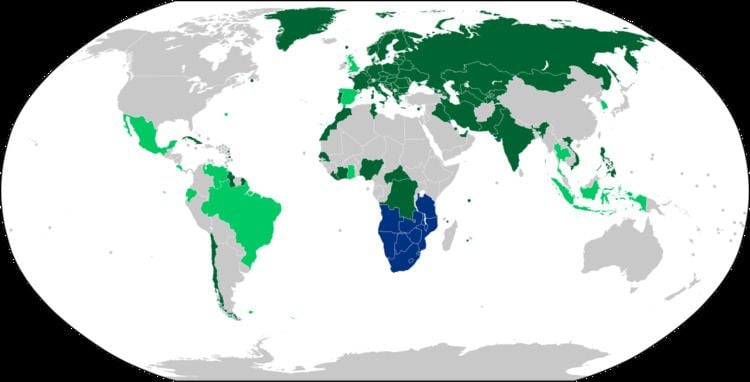Signed 8 November 1968 Effective 6 June 1978 Parties 65 | Signatories 35 | |
 | ||
Condition Ratification by 15 states | ||
The Convention on Road Signs and Signals, commonly known as the Vienna Convention on Road Signs and Signals, is a multilateral treaty designed to increase road safety and aid international road traffic by standardising the signing system for road traffic (road signs, traffic lights and road markings) in use internationally.
Contents
This convention was agreed upon by the United Nations Economic and Social Council at its Conference on Road Traffic in Vienna 7 October to 8 November 1968, was concluded in Vienna on 8 November 1968 and entered into force on 6 June 1978. This conference also produced the Vienna Convention on Road Traffic, which complements this legislation by standardising international traffic laws.
The convention revised and substantially extended the earlier 1949 Geneva Protocol on Road Signs and Signals, itself based in turn on the 1931 Geneva Convention concerning the Unification of Road Signals.
Amendments, including new provisions regarding the legibility of signs, priority at roundabouts and new signs to improve safety in tunnels were adopted in 2003.
Both the Vienna Convention and the Geneva Protocol reflected a common consensus on road traffic signs that evolved primarily in Europe in the mid-20th century. Most jurisdictions outside Europe have not adopted either treaty, and maintain their own systems of road traffic signals. For example, the U.S. Manual on Uniform Traffic Control Devices (MUTCD) does not follow the symbol policy espoused by the Vienna Convention; for example signs for speed limits and forbidden parking are among the most visible differences. In order to make it accepted in as many countries as possible, the convention allows some variations, for example danger warning signs can have triangular or square diamond shape and road markings can be white or yellow.
An alternative convention called the SADC-RTSM, provided by the Southern African Development Community, is used by 11 countries in southern Africa. It follows many of the similar rules and principles as in the Vienna Convention.
Road signs
In article 2 the convention classes all road signs into a number of categories (A – H):
The convention then lays out precise colours, sizes and shapes for each of these classes of sign:
† May be written in English or the national language
It also specifies the symbols and pictograms which may be used, and the orientations in which they may be used. When more than one is available, the same one must be used nationally. All signs, except for those that do not apply at night, must be reflective enough to be seen in darkness with headlights from a distance.
Road markings
The convention also specifies road markings. All such markings must be less than 6 mm high, with cat's eye reflectors no more than 15 mm above the road surface. The road markings shall be white or yellow.
The length and width of markings varies according to purpose, although no exact figures for size are stated; roads in built up areas should use a broken line for lane division, while continuous lines must only be used in special cases, such as reduced visibility or narrowed carriage ways.
All words painted on the road surface should be either of place names, or of words recognisable in most languages, such as "Stop" or "Taxi".
Traffic lights
The Convention specifies the colours for traffic lights and their meanings, and places and purposes lights may be used for, like so:
Red flashing lights may only be used at the locations specified above; any other use of the lights is in breach of the convention. Red lights must be placed on top when lights are stacked vertically, or on the side closest to oncoming traffic if stacked horizontally.
Contracting parties
The convention has 65 state parties at August 2016: Albania, Austria, Bahrain, Belarus, Belgium, Bosnia and Herzegovina, Bulgaria, Central African Republic, Chile, Côte d'Ivoire, Croatia, Cuba, Cyprus, Czech Republic, Democratic Republic of the Congo, Denmark, Estonia, Finland, France, Georgia, Germany, Greece, Guyana, Hungary, India, Iran, Iraq, Italy, Kazakhstan, Kuwait, Kyrgyzstan, Latvia, Liberia, Lithuania, Luxembourg, Macedonia, Moldova, Mongolia, Montenegro, Morocco, Netherlands, Nigeria, Norway, Pakistan, Philippines, Poland, Portugal, Romania, Russia, San Marino, Senegal, Serbia, Seychelles, Slovakia, Slovenia, Sweden, Switzerland, Tajikistan, Tunisia, Turkmenistan, Turkey, Ukraine, United Arab Emirates, Uzbekistan, Vietnam, and Zambia.
The only countries in Europe that are not signatories to the Convention are Iceland, Ireland, Andorra, Malta, and Liechtenstein; Spain, the United Kingdom, and the Holy See are all signatories but have yet to ratify the Convention.
The only countries in Asia that are not signatories to the Convention are Bangladesh, Malaysia, Vietnam, Taiwan, China (including Hong Kong and Macau), Laos, Japan, Israel, Palestine, Saudi Arabia, Jordan, Lebanon, Syria, Armenia, Yemen, Oman, North Korea, and Afghanistan; Indonesia, South Korea and Thailand are all signatories but have yet to ratify the Convention.
